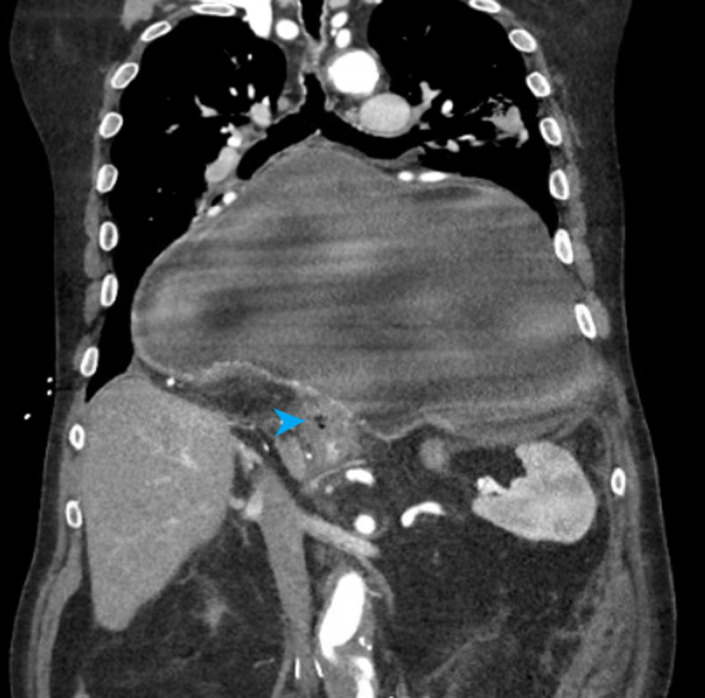Abstract
Acute gastric volvulus is a rare yet life‐threatening condition with mortality ranging from 30% to 50% if not treated promptly. The stomach rotates on itself causing strangulation precipitating necrosis, cameron lesions, and perforation. Long‐standing paraesophageal hernia is a common cause of organoaxial gastric volvulus.
Keywords: acute gastric volvulus, organoaxial volvulus, paraesophageal hernia
Acute gastric volvulus is a rare yet life‐threatening condition with mortality ranging from 30% to 50% if not treated promptly. The stomach rotates on itself causing strangulation precipitating necrosis, cameron lesions, and perforation. Long‐standing paraesophageal hernia is a common cause of organoaxial gastric volvulus.

1. CASE HISTORY
Acute gastric volvulus is a rare yet life‐threatening condition with mortality ranging from 30% to 50% if not treated promptly. The stomach rotates on itself causing strangulation (Figure 1) precipitating necrosis, Cameron lesions, and perforation. 1 Long‐standing paraesophageal hernia is a common cause of organoaxial gastric volvulus. 2
FIGURE 1.

Schematic representation to understand the orientation of types of gastric volvulus
1.1. Questions
Which complication is an important indication for emergent surgery in long‐standing paraesophageal hernia?
1.2. Answer
We present a case of paraesophageal hernia complicated with organoaxial volvulus.
A 75‐year‐old man with medical history significant for atrial fibrillation on warfarin, recent endovascular abdominal aortic artery aneurysm repair, and long‐standing paraesophageal hernia presented with progressive worsening abdominal pain associated with coffee‐ground emesis of one‐week duration. Physical examination was remarkable for epigastric tenderness without guarding or rigidity. Laboratory workup revealed hemoglobin 13.7 g/dl, and prothrombin time (PT)/international normalized ratio (INR) 72 s/9.51. Emergent computed tomography angiography (CTA) for concerns of aortic pathology carried out demonstrated organoaxial volvulus with the entire stomach in the posterior mediastinum and small contained duodenal perforation (Figure 2). Given the acuity of the severe gastric distension and hemodynamic instability, nasogastric tube was placed after multiple failed attempts for immediate gastric decompression with simultaneous reversal of PT/INR with vitamin K and fresh frozen plasma along with packed red blood cell transfusion. A significant drop in hemoglobin to 7.7 g/dl was noted in the first 24 h. Repeat CT illustrated reduction in stomach distention. Esophagogastroduodenoscopy (EGD) revealed a tortuous esophagus with multiple large ulcerations in the body of the stomach and esophagus (Figure 3), with no active bleeding. The patient later underwent laparoscopic transabdominal repair as definitive treatment.
FIGURE 2.

Computed tomography angiography showing the entire stomach in the posterior mediastinum and the blue arrowhead pointing to the extraluminal air suggestive of perforation
FIGURE 3.

Esophagogastroduodenoscopy (EGD) showing multiple deep ulcerations in the body of the stomach
CONFLICT OF INTEREST
None.
AUTHOR CONTRIBUTIONS
Justine Chinnappan and Murtaza Hussain involved in acquisition, and drafted and reviewed the manuscript. Smit S. Deliwala conceptualized and designed the manuscript. Ghassan Bachuwa reviewed the manuscript.
CONSENT
Published with appropriate informed written consent from the patient.
ACKNOWLEDGMENTS
None.
Chinnappan J, Hussain MS, Deliwala SS, Bachuwa G. Acute organoaxial gastric volvulus—A dangerous twist. Clin Case Rep. 2022;10:e05785. doi: 10.1002/ccr3.5785
Funding information
None
DATA AVAILABILITY STATEMENT
Data sharing is not applicable to this article as no new data were created or analyzed in this study.
REFERENCES
- 1. Deliwala SS, Hussain MS, Ponnapalli A, Bachuwa G, Gurvits GE. Black oesophagus, upside‐down stomach and cameron lesions: cascade effects of a large hiatal hernia. BMJ Case Rep. 2021;14(11):e246496. doi: 10.1136/bcr-2021-246496 [DOI] [PMC free article] [PubMed] [Google Scholar]
- 2. Lopez PP, Megha R, eds. Gastric volvulus [Updated 2021 Nov 14]. In: StatPearls [Internet]. StatPearls Publishing; 2022. https://www.ncbi.nlm.nih.gov/books/NBK507886/ [Google Scholar]
Associated Data
This section collects any data citations, data availability statements, or supplementary materials included in this article.
Data Availability Statement
Data sharing is not applicable to this article as no new data were created or analyzed in this study.


